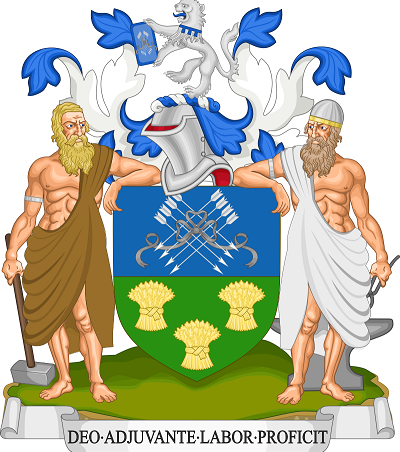
Sheffield
- a Home of Football
- from Cradle
to Crash and
Come-Back?
It is beyond doubt with current research both from the city itself and elsewhere that Sheffield, in the form of the doyen of British clubs, Sheffield F.C., was crucial and even pivotal to the creation, indeed preservation of the earliest Association and thus the game as a whole. No Sheffield, No Soccer might be a mantra in just the same way as is No Scotland, No Modern Soccer. And this was despite the fact that for the best part of two decades and half from genesis it seems to have continued to prefer, at least in part, and practice not the London but its own Sheffield Rules. Yet it, the club and by default the city, was there if not at the very first step in 1863 towards the London-based Football Association then within a few months, perhaps weeks, urging by letter and even in person the minority who had chosen the game with largely just the feet, rather than the majority for hands plus feet, to remain steadfast. And whether it was actually a full member of the nascent Football Association or not it would from then be, a) at meeting after meeting in the form, it is said, initially of future Secretary, twenty-one year old Harry Chambers, significantly a trainee solicitor, as were both London's FA and Sheffield F.C.'s founders, b) in 1865 suggesting itself as the organisation's first, representative opposition, travelling from Yorkshire to London to make it happen and c) in 1867 in the form of former Secretary, William Chesterman, be there to provide back-bone as that same organisation teetered on dissolution and then even d) arguably providing, in the Youdan Cup and pre-Alcock, the model for the FA Cup.
All this was largely off-field but also in its match-reporting there is evidence that not just Sheffield F.C. but the Sheffield game more generally provides early examples of passing, heading and position and a number of its rules and and innovations in equipment were incorporated into those of the Association game. Indeed it would still after 1870 continue to contribute similarly even as on--field success went missing and that local game would drive itself into a cul-de-sac; one from which it would threaten to emerge in 1881-82 with Sheffield Wednesday reaching the FA Cup semi-final, having reached the fourth round the season before and only doing so again in 1882-3, but not really do so for the best part of two decades, its place taken certainly on the playing-front initially by Glasgow, then by the West of Scotland and eventually by the Scottish game more generally.
And here is the evidence of the cul-de-sac. From 1872-3, the years of the successful planting of the Association game North of the Border, and for the next fifteen seasons Sheffield would produce, with the Clegg brothers, only seven England internationalists and really only two stars, both in the 1870s and early 1880s. It would take a decade from 1883 before another would arrive, and even he, Fred Spiksley, was actually a Lincolnshire-man. And of the two one, the fine winger, Billy Mosforth, would achieve only a single win over Scotland and even then in controversial circumstances, and the other, the defender cum half-back, Jack Hunter, would never have even that success in four attempts, in fact, be in the team in 1881 to suffer the worst ever defeat by the Auld Enemy and in eight representative appearances for Sheffield against Glasgow see again just the one victory.
In part this situation was probably due to the Sheffield FA, formed in 1868, splitting after less than a decade and remaining thus for the next ten years, two thirds of its members accepting London rules and the remainder staying with the local ones, albeit differences were by then small. And that split may well have been a product of two factors. The first was a change of guard at the top in the English capital from essentially middle- to upper middle-class and public school in 1874-7 and onwards. And the second was before that in 1869 a stepping-back of the first President of the Sheffield FA, none other than Chambers, with from 1868 a year as Vice-President and then fourteen to 1883 as President for John Charles Shaw followed perhaps as early as 1873 and certainly from 1876 by William Dix as Secretary and then also Treasurer. And both seem, whilst clearly alienating emergent, local football teams, hence the split, to have developed a less apparently collegiate and in the end a more subservient relationship with London than had been the case.
And there was something else, perhaps even as a result; a gradual loss of impulsion, even self-confidence, that saw Sheffield teams be first beaten by Glasgow teams and second adopt the Scottish 2-2-6 formation, even importing prominent Scottish players, Andrew(s) and Lang, on a shamateur basis, yet clearly and with worse results still, in parallel with much of the rest of England over much the same period, failing to match us Jocks tactically.
In fact it would not be until 1889-90, after reconciliation of the rift between Sheffield and Sheffield New under what would become the enduring figure of the city's game, Charles Clegg, that there would be a partial re-emergence with Wednesday, from outwith the then new Football League and with a largely local team, reaching the FA Cup Final but being badly beaten. The club would not join the League until 1892, really not be fully back until 1896 when the Cup was actually won, but fielding a team that contained five Scots, Spiksley and just one Sheffielder, with for the city as whole the come-back arguably only truly completed as non-Scots but even then still mainly non-local Sheffield Utd. won that same competition three seasons later in 1899, was runner-up in 1901 and be champion once more in 1902.
Back to the SFHG Home page